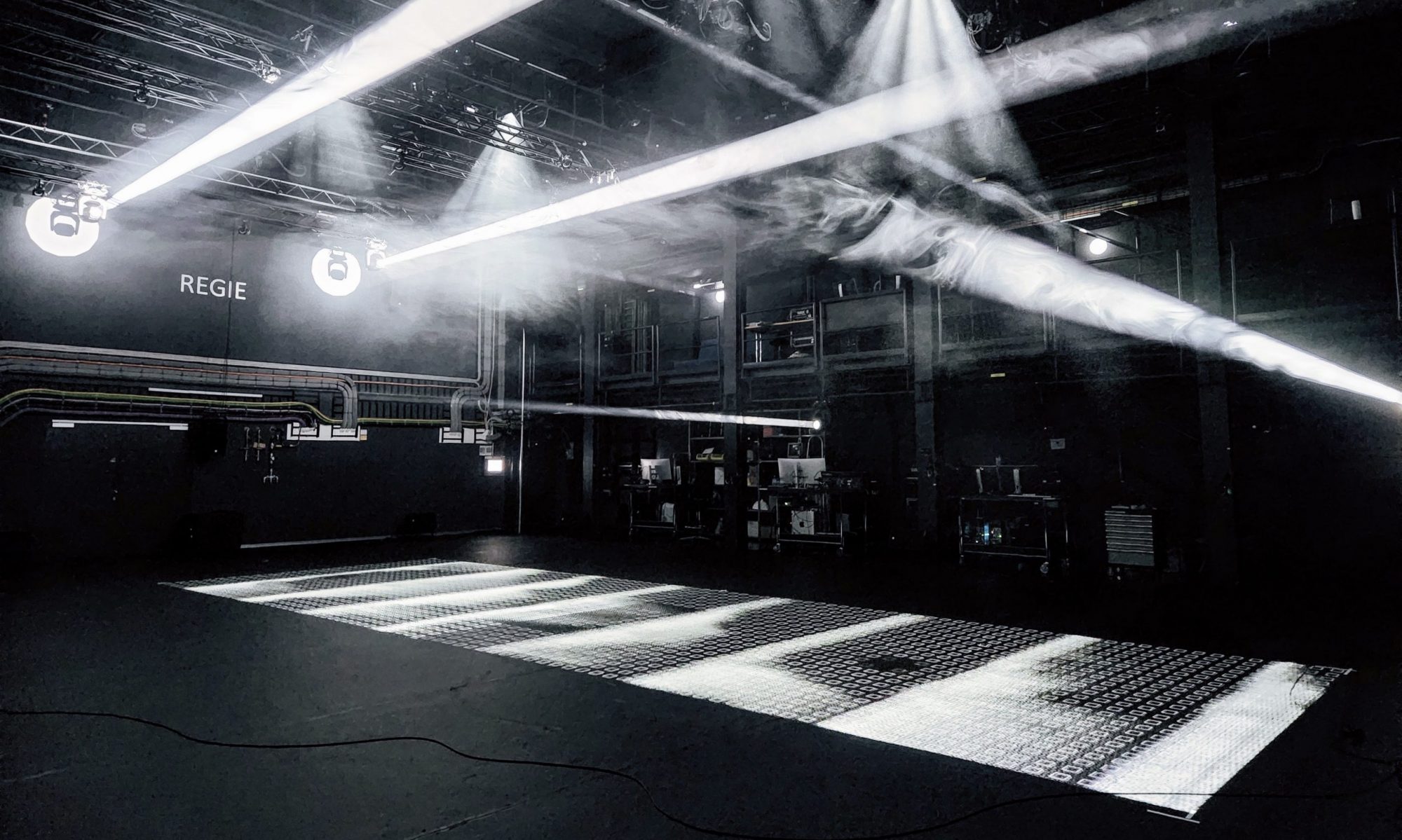On this page you can find current and upcoming projects. We develop and host a variety of projects, such as graduation student projects, internal research projects and collaborations with external partners.
Conversations with Puppets
Part of the exhibition “The Museum of the Future – 17 Digital Experiments”
29th August 2025 untill 1st February 2026, Museum für Gestaltung Zürich
About the exhibition
The exhibition ‘The Museum of the Future – 17 Digital Experiments’ examines the potential, areas of application, forms of content expansion and implementation options relating to digitality in forward-looking museum and educational work. This year, a major exhibition (17 exhibited projects) will make the ‘state of the art’ accessible to the public with several installations, a website and a broad-based educational program (analogue and digital).
About the project
The Immersive Arts Space` contributing project is called ‘Conversations with Puppets’. It offers an innovative and interactive experience in which the visitors become an integral part of Fred Schneckenburger’s puppet cabaret. After World War II, the versatile artist Fred Schneckenburger founded the “Puppencabaret Fred Schneckenburger” in Zurich and enjoyed success throughout Europe with his sketches. His expressionistic, surreal stick puppets were characterized by their idiosyncratic and unique design. In terms of content, his pieces criticized the hypocrisy and contradictions of the conservative bourgeoisie, with stereotypical Swiss characters in the form of puppets.
Technical architecture
Three of the original stick puppets – Kaspar, der Polizist and die Moral/das Fräulein – from the collection of the Museum für Gestaltung Zürich have been photogrammetrically captured and digitized. 3D artists worked out the details of the textures and cloths to recreate and animate the physical appearance of the puppets surfaces. In addition, Motion Capture recordings were used to add more puppet-like movement to the avatars.
Large Language Models (LLMs) and generative AI form the basis of the interaction and conversations. In order to create a character prompt for each puppet, the original audio recordings of the pieces in which the specific puppets appeared, were transcribed and analyzed. The result of the analysis were distillations of the most characteristic words and/or expressions of the puppets, which were then inserted in the prompt. In addition, to the character references the prompts were further developed to fit the role of each puppets within the exhibition and its dramaturgy.
Further, the interaction is supported by different systems, aiming at a flawless interaction and conversation. SAR motion, a system internally developed by Florian Bruggisser, detects via a camera the movement and body of a visitor. This triggers the interaction and the puppet starts to talk.
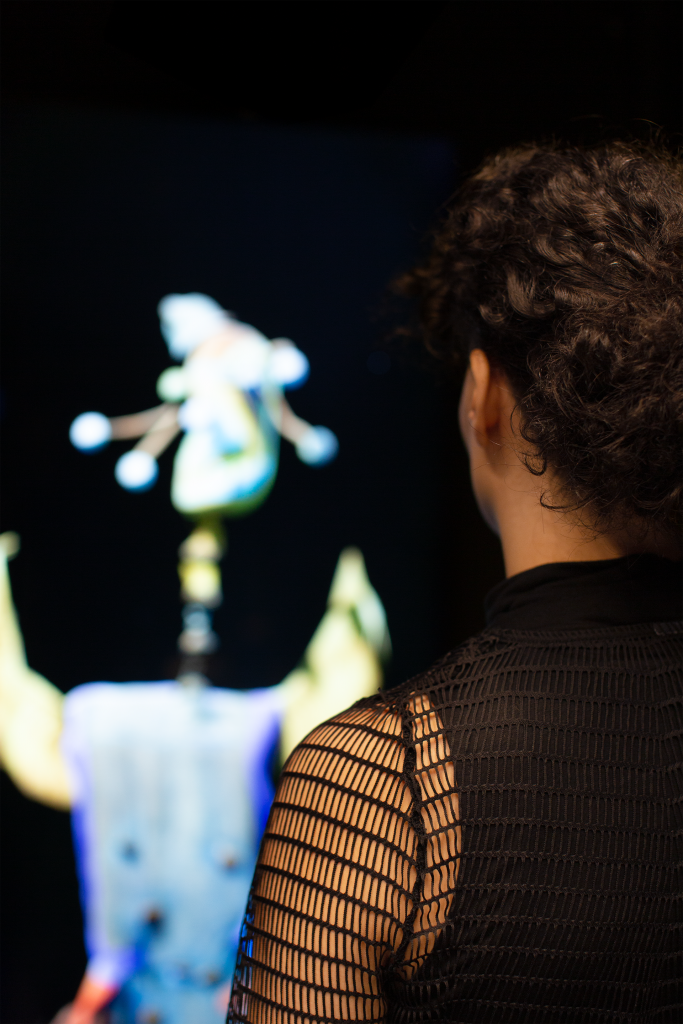
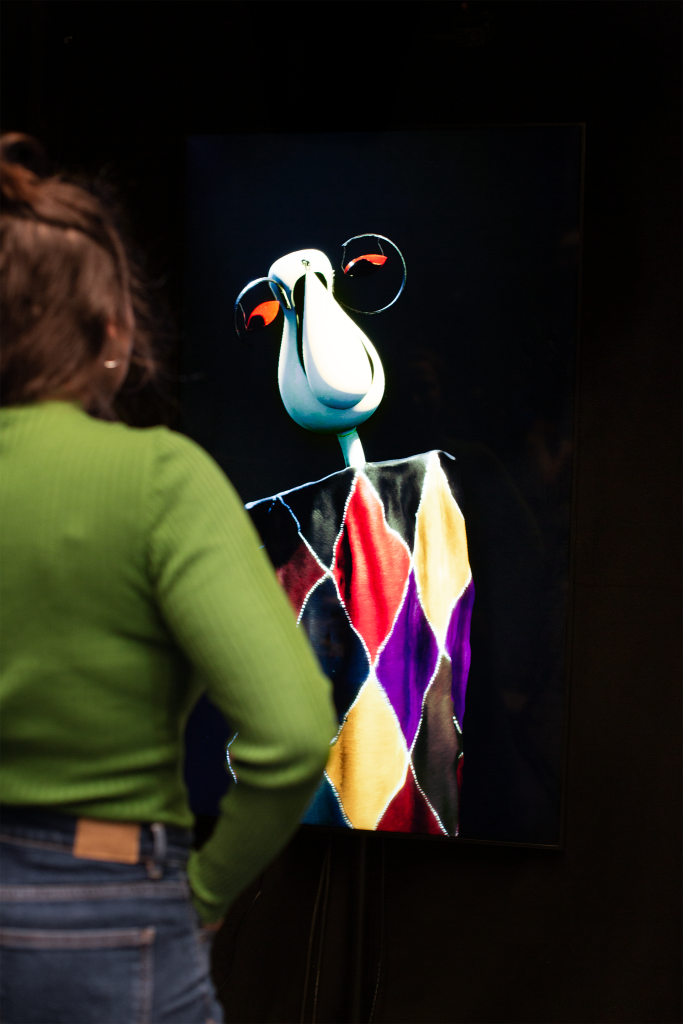
Team:
Florian Bruggisser: Technical Lead and Software Development
Oliver Sahli: Idea, Interaction and System Integration
Chris Elvis Leisi: Interaction and Experience Design
Stella Speziali: 3D Artist, Animation
Johannes Köberle: 3D Artist
Corinne Soland: Motion Capture
Pascal Lund-Jensen: Audio Engineering
Sébastien Schiesser: Technical support
Kristina Jungić: Project coordination
Prof. Christopher Salter: Initiative / Director IAS
Photo credits: Chris Elvis Leisi, ©ZHdK 2025
Official website: https://museum-gestaltung.ch/de/ausstellung/museum-future
Self-Organized Reality
Development of emergent person-environment behaviors in Mixed Reality environments, Leading House Japan, 2024/25
This interdisciplinary project is an international collaboration between The Ikegami Lab at the University of Tokyo and Immersive Arts Space. The project aims to study social co-presence (the sense of being with others) in a shared mixed reality (MR) environment, Here, MR is achieved via “video passthrough”– a technique which delivers live video images through tiny cameras in the head mounted display which approximates what one would see if directly looking into the real surrounding world. The project’s aim is to measure how self-organization in this MR space, characterized by changes in information richness and concurrency could affect the sense of co-presence of others inhabiting the same MR space. Self-organization, here defined as emergent structures that evolve without central control and in response to environmental stimuli, will be achieved by creating audio-visual environments through generative AI processes that are controlled in real time by both physiological markers and of non-verbal interaction (interpersonal spatial distance).
‘Leading Houses’ are short term projects intended as start-up funding for international research projects. These are competence networks mandated by the State Secretariat for Education, Research and Innovation (SERI).
Collaborating Reseachers: Chris Elvis Leisi, Oliver Sahli, Chris Salter
Towards new multi-user dramaturgies in interactive and immersive performance
Leading House Asia, 2024/25
This interdisciplinary project brings together two internationally recognized labs working at the intersection of arts and sciences – the Immersive Arts Space and the Visualization Research Center (VRC) at the Hong Kong Baptist University (HKBU). The project will develop a pilot prototype for a new kind of multi-user interactive performance where the audience can individually and collectively influence the dramaturgical evolution of the event. Through a major Hong Kong government innovation grant, the VRC under the leadership of Jeffrey Shaw, a pioneer in the development of immersive technological environments, has developed a world-leading interactive multimedia visualization system called nVis.
‘Leading Houses’ are intended as start-up funding for international research projects. These are competence networks mandated by the State Secretariat for Education, Research and Innovation (SBFI).
Collaborating Reseachers: Martin Fröhlich, Stella Speziali, Chris Salter
Bodies Remediated: Another Next First Conversation
International Workshop, 12. & 13.09.2024
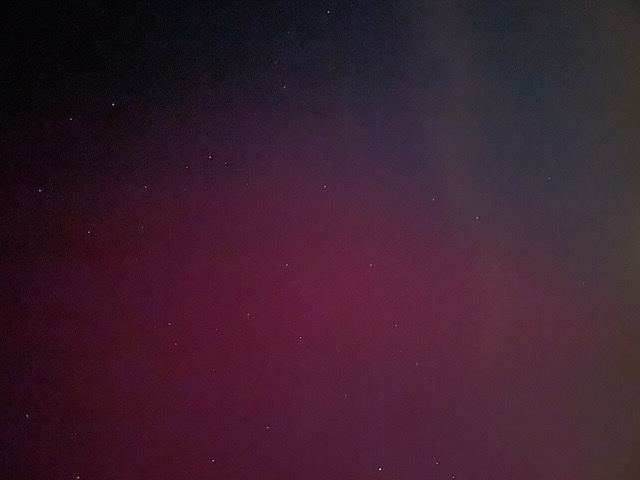
How do skilled practices in current domains of art, science, and technology engage with new forms of digital remediation? What contemporary “dialectic[s] of de- and re-skilling” (Bishop 2017) are at play? This workshop sets out with tackling the raised question. Therefore, it brings together qualitative researchers in the social sciences, arts practitioners, and education scholars approaching and reflecting upon Bodies Remediated in and beyond their current work.
The international two-day workshop takes place at Kino Toni (3.G02) and is open to the public. For further information, please contact Philippe Sormani
SNF-project: Performing Artificial Intelligence
Swiss National Science Fund (SNSF) project, 2025-2029
Performing AI’s goal is to contextualize AI as a dynamic social and cultural artifact that is discursively and practically constituted (that is, performed) in specific contexts and situations. In other words, what does “AI” do, why and how does it do what it does, and what effects does it produce across different disciplines? The project takes the theoretical and conceptual lenses of performance and performativity for navigating AI’s messy entanglements between the social and political, technical and aesthetic.
The project has three core objectives: 1) understand how AI is performed differently in its multiple constitutions (discursive, material, situated) and in/across disciplines; 2) provide interdisciplinary research and training opportunities for a next generation of researchers to grapple with the complex, multi-scalar nature of AI; and (3) explore new forms of critical public engagement with AI across arts, science, policy and technology.
Performing AI will thus study AI’s performances in the making in three sites – the policy space, experimental scientific and artistic research labs, and otherwise mundane spaces. Examining AI in the making, the project explores how AI is discursively enacted in policy and governance and examines the material agency of AI in robotics, artificial life and digital arts where human actors have to interact with machinic systems in real time. It also draws upon and develops ethnographic and ethnomethodological approaches to trace the situated action and production of AI in public settings of the everyday including a museum as well as in hybrid art, science and technology laboratories.
Project Partners:
Anna Jobin (University of Friobourg)
Olivier Glassey (University of Lausanne)
Takashi Ikegami (University of Tokyo)
Christopher Salter (Zurich University of the Arts)
SNSF-Project: Spatial Dis/Continuities in Telematic Performances
Unraveling distributed space through 3D-audio, embodiment and Spatial Augmented Reality. SNSF-project by the Institute for Computer Music and Sound Technology (ICST), 2020-2024.
Telematic performances connect two or more geographically distant stages via communication technologies in such a way that performers can interact with each other. The audience experiences a specific insight into the overall event at each of the different locations, with the real presence of the local and virtual presence of the performers simultaneously overlapping.
Previous research has focused on technological developments that enable a high-quality connection with low latency, as well as the minimization or artistic handling of latency, i.e. the delay in the transmission of audio and video signals. Due to the mostly flat representation of the remote performers on a static screen (video) and in stereo monitoring (audio), the spatial information of the remote stage is largely lost. The research project investigates how spatial characteristics from the stages involved are superimposed. It draws on current technologies such as 3D audio (where sounds are reproduced in high spatial resolution) and spatial augmented reality techniques (where visual information from the remote stage is integrated into the local scenography by means of motion tracking and video mapping). Particular attention is paid to forms of embodiment and communication processes that enable an immersive experience.
Credits:
Patrick Müller (ICST, project lead)
Benjamin Burger (ICST)
Joel de Giovanni (ICST)
Martin Fröhlich (IAS, ICST)
Roman Haefeli (ICST)
Johannes Schütt (ICST)
Matthias Ziegler (ICST)
Hannah Walter (MA Transdiciplinary)
Public Lecture Series (Spring Semester 2024)
Immersive Arts: Performative Perspectives on Immersion
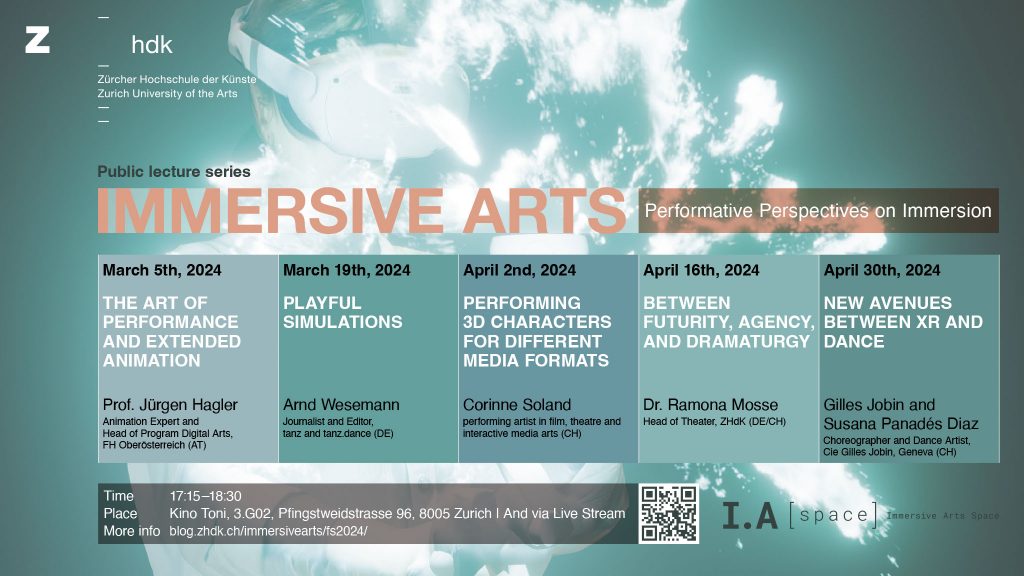
The immersive arts lecture series for Spring Semester 2024 investigates questions of immersion from the perspectives of the performing arts including dance, theater and even real time animation. Our exciting list of five guest lecturers includes Prof. Juergen Hagler (the head of the Ars Electronica animation jury), Arnd Wesemann (journalist and long-time editor of tanz), Corinne Soland (performing artist in film, theatre and interactive media arts), Dr. Ramona Mosse (head of the theater program at the ZHdK) as well as Gilles Jobin and Susana Panadés Diaz (world renowned choreographer and collaborating dance artist working with real time motion capture).
The pubic lecture series take place at the Kino Toni (room 3.G02, Pfingstweidstrasse 96) from 17:15-18:30h. They will be also available via live stream.
THE ART OF PERFORMANCE AND EXTENDED ANIMATION
Prof. Jürgen Hagler | March 5th, 2024
Performance is a word that evokes a multitude of interpretations. In the simplest terms, performance describes the act of executing a task or function, but it also encompasses the staging and presentation of the act itself. As a form of artistic expression, such an act can be a play, a piece of music, a dance choreography, or in the case of this lecture, live animation. In contrast to animated films, performative acts are typically unique, and though they can be repeated, each differs in some way. Immediacy and unpredictability, among many other qualities, are the building blocks of performance in this context. But all animations, whether pre-recorded or live, are essentially a composition of static elements brought to life as a performative act.
Jürgen Hagler (AT) studied art education, experimental visual design, and cultural studies at the University for Art and Design in Linz, Austria. He currently works as a professor of Computer Animation and Animation Studies in the Digital Media department at the Hagenberg Campus of the University of Applied Sciences Upper Austria. Since 2014 he a leading researcher of the research group Playful Interactive Environments with a focus on the investigation of new and natural playful forms of interaction and the use of playful mechanisms to encourage specific behavioral patterns. Since 2009 he is the curator of the Ars Electronica Animation Festival and initiator and organizer of the symposium Expanded Animation
PLAYFUL SIMULATIONS
Arnd Wesemann | March 19th, 2024
It’s funny: All theatres, next to their museum function, assert a claim to political realism. For example, a theatre that only would like to see poverty represented on the stage by the poor would therefore be a Poor Theatre. Likewise, a theatre that would only allows digital artificiality would therefore be called an Artificial Theatre. Are either of these true? Can a theatre become a place where even non-human sensors, data and artificial intelligence play a role? Or isn’t the theatre the place where precisely everything plays a role, in this case, even technologies. In this sense, Theatre would therefore be the place where we would no longer blindly trust the calculations of models or the actions of autonomous software. This talk proposes therefore the question: Don’t we owe technology one thing above all else: a playful approach to it? Raise the curtain on a theatre of true virtuality which will allow us to experience all kinds of possibilities.
Arnd Wesemann (DE) is long-time editor of the German magazine tanz. He studied Applied Theatre Studies, a then newly formed professional education program of the University of Giessen, graduating in 1987. In 1990 he became a free-lance writer on advanced theatre and arts phenomena, publishing essays and reports on contemporary theatre, dance and New Media events in magazines such as tanz, Theater der Zeit and the Swiss-printed magazine Musik & Theater. He has been a regular contributor to the Süddeutsche Zeitung, reporting about new tendencies in European theatres. In the field of electronic media, dance and the respecting performing arts, he freelanced for Die Zeit, Frankfurter Rundschau and Screen Multimedia. In October 1994 he published a monograph on the Flemish avant garde stage director Jan Fabre with Fischer-Verlag and the book Data dummies & Net nomades with Fannei & Walz, Berlin. Since 1997 he is editing Europe’s Leading Dance Magazine, tanz, now in his 25th year and now the Global dance platform tanz.dance. He has been lecturing, teaching on Dance und New Media as well as serving on numerous juries and panels.
PERFORMING 3D CHARACTERS FOR DIFFERENT MEDIA FORMATS
Corinne Soland | April 2nd, 2024
In the world of performing arts, actors and performers are not exclusively in demand for theater, film or circus. Characters are also brought to life in video games, interactive installations and virtual reality films. Corinne Soland leads us through movement exercises to understand the process of training locomotion for “the Volume” – the capture stage. What are differences in Game movement versus Narrative 360° Stories? The Immersive Arts Space researcher gives insights on how to teach performance with MoCap technologies and if (& how) this technology can shape and shift a performance. With a focus on acting, the lecture provides key concepts and current topics of Corinnes research at the IASpace in chosen past and current projects as well as accumulated knowledge of production at the intersection with performers’ needs in the Volume.
Corinne Soland (CH) is a performing artist in film, theatre and interactive media arts. After completing a Motion Capture training with Performance Captured Academy (PCA UK) in 2019, Corinne has recorded movement for both 2D and 3D programs. Selected projects include Kusunda VR (NowHere Media, GER/INDIA), The Conspiracy (Third Party Film, USA), Amazing Monster! (wowl!, SmallCreative CH/FR) and LimitsVR (Tell Me the Story Prod. CH/FR). A freelance actor and voice over talent for both animation as well as live-action projects, Corinne’s latest roles are Dimitri in the TV Series “Guetnachtgschichtli” (SRF) and Anna in Neumatt (SRF, Zodiac, Netflix). Since 2019 Corinne is part of the Immersive Arts Space team as a research associate. Corinne teaches students coming from different disciplines how to translate their movement into a characters’ body narrative through the MoCap technology in Workshops and ZHdK seminars.
THE NETWORKED STAGE: BETWEEN FUTURITY, AGENCY, AND DRAMATURGY
Prof. Dr. Chris Salter | April 16th, 2024
Theatres of the future are frequently invoked in the German-speaking cultural landscape to mark a crisis of institutions and to question theatre’s mandate in a publicly funded system. Yet, in this talk, Ramona Mosse would like to coin the futurity of theatre along a different trajectory and map the digital dramaturgies of the networked stage, i.e. a radically expanded theatre in which digital technologies have reshaped the space of performance and in which our established concepts of agency and authorship no longer hold. What is at stake, then, in such a hybrid future of theatre that had been so frequently called upon during the COVID pandemic? How does the reality differ from the manifestoes for a digital theatre future, spurred on by the 772% increase in digital theatre ticket sales (ETC Digital Theatre Study) during the pandemic? To explore these questions, Mosse will use the founding of and artistic programming at the HAU4, the digital stage of the HAU Hebbel-am-Ufer Theater in Berlin, as a case study. In particular, its resident artist group Interrobang moves into focus with their recent work “Commune AI” (2023), in which a digital audience sets out to build a virtual community, moderated by an AI.
Ramona Mosse (DE/CH) is the Head of Theatre at the Zurich University of the Arts. She has taught at the Free University Berlin, the Goethe University Frankfurt, Bard College Berlin, and Columbia University. In her research, she explores digitality in performance, genre and media in/of the theatre, and contemporary political performance practices. From 2021-2022, she headed up the VolkswagenFoundation funded research project Viral Theatres, which documents the aesthetic shifts of pandemic theatre-making.
COSMOGONY: NEW AVENUES BETWEEN XR AND DANCE
Gilles Jobin and Susana Panadés Diaz | April 30th, 2024
Cie Gilles Jobin is focusing on technology and innovation for real time performances at a distance. Creating multiple groundbreaking projects Gilles Jobin is recognized as one of a leading creative force in the XR world. Gilles is regularly invited as an international guest lecturer on dance and technology in Europe, Asia and Americas. Geneva’s company studio is equipped for motion capture and digital creation and structured as an affordable research and production center for motion capture and digital technology from the point of view of the performing arts. In this talk, Jobin and his main dancer/collaborator Susana Panadés Diaz will discuss the company’s artistic process working with technologies like Motion Capture and Virtual Reality.
Gilles Jobin (CH) is a choreographer living and working in Geneva whose productions have been performed all over the world since 1995. Based in London from 1997 to 2004 he created the groundbreaking pieces A+B=X (1997), Braindance (1999), The Moebius Strip (2001) and Under Construction (2002), relying on choreographic language outside of established aesthetic frameworks that included forays into visual arts and live art. In 2003 he created TWO-THOUSAND-AND-THREE for the 22 dancers of the Ballet of the Grand Théâtre de Genève for a performance that “transcends both classical and contemporary dance” (Libération). His creations are being presented in major film festivals such as the Sundance Film Festival (2018 and 2020) and the Venice Film Biennial (2018 and 2020), leading dance festivals such as the Lyon Dance Biennial (2018) or BAM (2019) in New York or museums such as Haus For Electronishe Kunst / HEK in Basel. With the same creative team and dancers behind Magic Window (2019) and Dance Trail (2020), two augmented reality dance pieces, followed by La Comédie Virtuelle a multiuser VR piece and La Comédie Virtuelle – live show a real time multiuser performance in VR. In 2021 he created Cosmogony, a dance piece motion captured live in the company’s studios and streamed in real time globally.
Susana Panadés Diaz (CH) studied classical and contemporary dance at the Institut del Teatre in Barcelona, before entering the P.A.R.T.S.programme in Brussels, directed by Anne Teresa de Keersmaeker. She worked with Caterina Sagna’s dance company in 2001 on the creation of Sorelline. From 1999 to 2004 she worked as a performer with Fabienne Berger in: Azur Blues, Natal, Océane Lili and Avril en mai. Since 2005 she has worked with Cie Gilles Jobin as a performer in a variety of projects. She was part of the cast for The Moebius Strip (Pachuca 2007) and A+B=X (Paris 2010) re-runs and has also worked as artistic assistant and multimedia manager for the company. Susana Panades Diaz is Cie Gilles Jobin’s main dance artist. She is an expert in digital motion capture. Member of the Cie Gilles Jobin since 2005, Susana is extremely familiar with the company’s dance style. Her role is to resolve issues related to the optimisation of motion capture from the point of view of the performers.
Zangezi
Zangezi is an ongoing artistic project developed by the Immersive Arts Space (artistic lead Chris Salter). The play has been presented and performed at various locations to date. Accordingly, the format and scope have changed and evolved.
Background
Zangezi is a Russian Cubo-Futurist poem/play written by the poet Velimir Khlebnikov 101 years ago in 1922. The story revolves around Zangezi, a prophet who speaks in the language ZAUM, a Russian word that is translated as “beyondsense.” Zangezi speaks with and can understand the birds, the gods, the stars and speaks in those languages as well as in poetic and also what K. called “ordinary” language. The Immersive Arts Space is working on this text because as a futurist work, Zangezi deals with is a fundamental human question which is increasingly becoming a problem for machines – what is the basis of language? Is language only about meaning based on syntax? Is it about predictable sequences? Rules and probabilities? Or is there something else going on that is universal and cosmic about language not as words and their meanings but as an act of sound?
Indeed, Khlebnikov, who had a mystical belief in the power of words, thought that the connections between sounds and meaning were lost during mankind’s history, and it was up to those in the future to rediscover them. 101 years later we ask how we might be able to approach Zangezi’s operations on multiple levels – cosmological, political, historical, technological – in a moment where we are increasingly surrounded by machines that produce something that appears like human language but in which there is no speaker, no body and no sound.
Zangezi – Performance
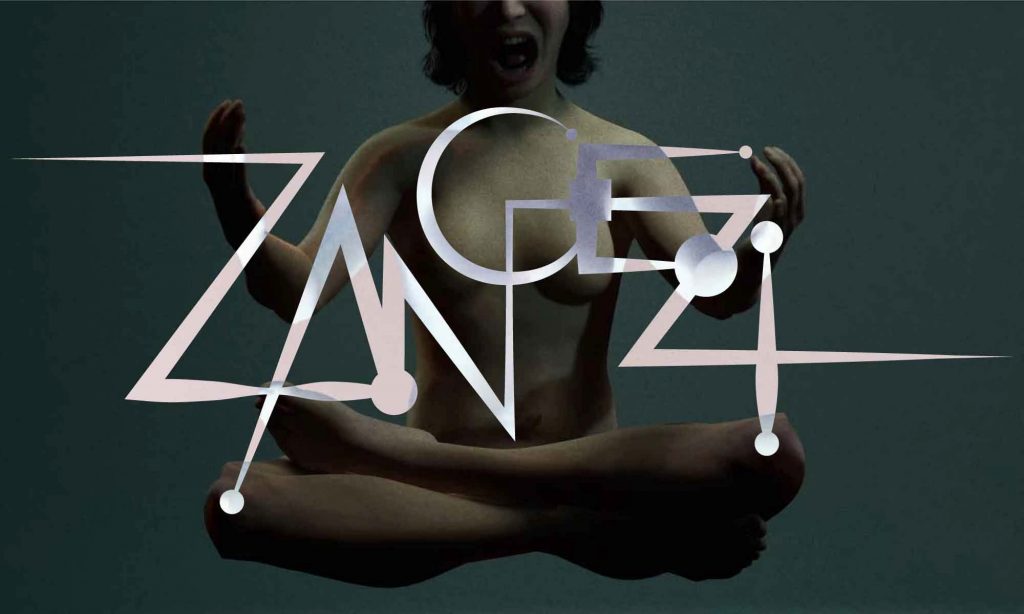
Under the artistic direction of Chris Salter (media artist and head of Immersive Arts Space), and in collaboration with the Immersive Arts Space (ZHdK) and an international team of artists from music, visual arts, performance, technology, and artificial intelligence, an immersive performance is being developed. The production combines spatial sound, lighting, music, graphics, and real-time AI-driven scenography generated with a game engine, alongside physical performance. A large-format LED wall serves as a central visual and lighting element. Digital landscapes, characters, and soundscapes are generated live and interact with the performers on stage. “Zangezi” addresses fundamental questions of the present: the relationship between humans and nature, the role of language, and war and conflict as driving forces of historical change. Following its premiere in Weimar, an international tour is in preparation.
World premiere will be at the Kunstfest Weimar 05. & 06.09.2025
Ticket are available [here]
Credits:
Chris Salter (Artistic direction)
Remco Schuurbiers (Artistic collaboration)
Sébastien Schiesser (Light)
Pascal Lund-Jensen (Sound)
Erik Adigard (Graphic design)
Timothy Thomasson (Virtual environments)
Gonçalo Guiomar (AI-Systems)
Ramona Mosse, Judith Rosmair (Dramaturgy)
Audrey Chen, Judith Rosmair (Performer)
Simon Lupfer (Technical coordination)
Miria Wurm (Production management)
Dietmar Lupfer (Producer)
With artistic contributions from Stefanie Egedy (BR), The Future of Dance Company (NG), Immersive Arts Space / ZHdK (CH), kyoka (JP), Raqs Media Collective (IN), Team Rolfes (USA), Pierre-Luc Senecal / Growlers Choir (QC/CA), Rully Shabara (ID), Stella Speziali (CH), Fernando Velasquez (BR)
A production by Muffatwerk Munich in co-production with Kunstfest Weimar, Immersive Arts Space / ZHdK Zurich, with support from XR Hub Bavaria.
Funded by the German Federal Cultural Foundation. Funded by the Federal Government Commissioner for Culture and the Media.
Zangezi – A Film Installation
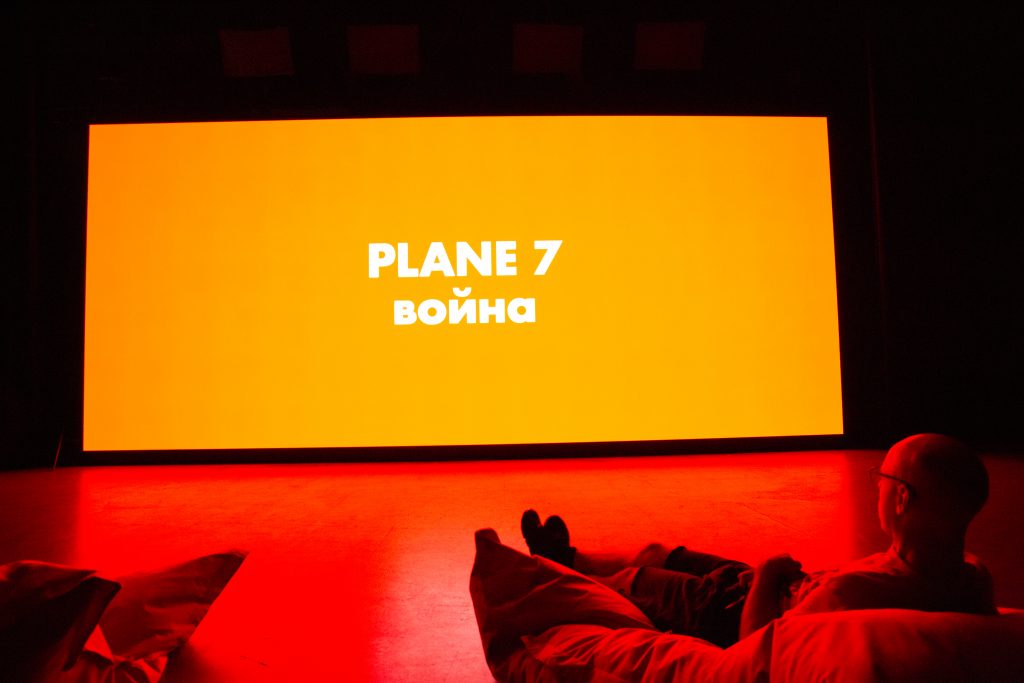
Zangezi was part of the Zurich Art Weekend in June 2025. For this event, the piece was further developed into a short film. It was shown on the state of the art LED wall in the Film Studio of ZHdK.
Zurich Art Weekend took place from 13th to 15th June.
Zangezi Experiments
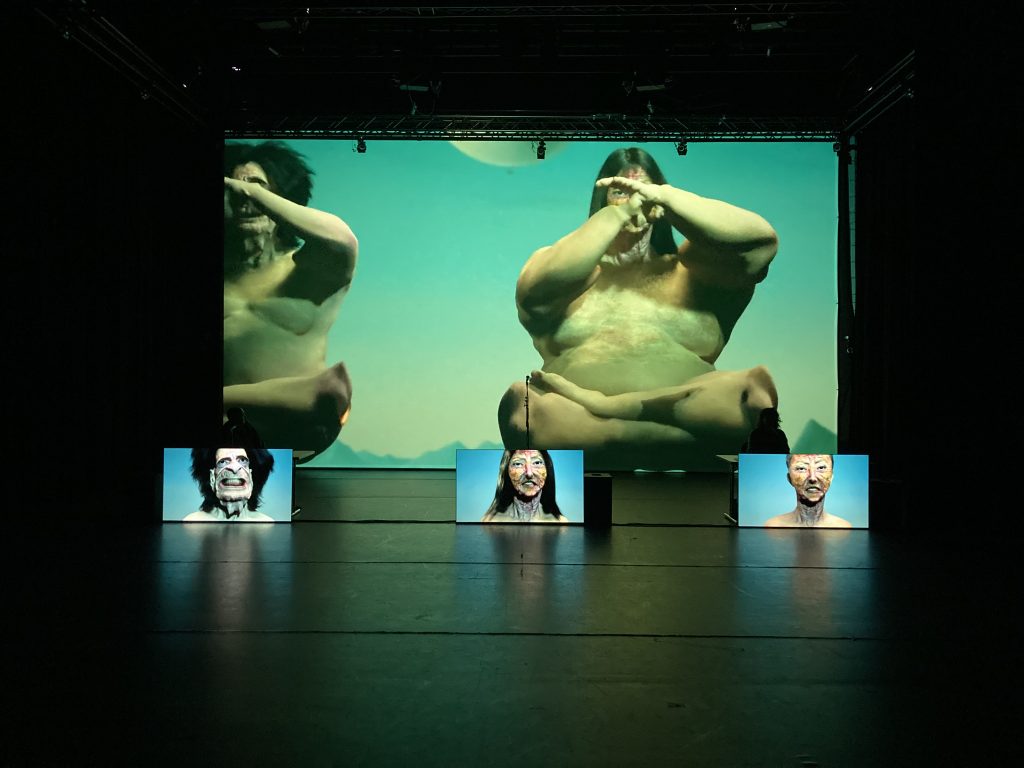
Zangezi-Experiments, a multimedia stage play, was performed at the MESH Festival. Before, fragments of the piece were recreated as a work in progress for the REFRESH#5 2023 festival, that took the form of a theatrically staged reading within the technical machine of the Immersive Arts Space itself.
Credits:
Chris Salter (Direction, Sound Design)
Corinne Soland (performer)
Luana Volet (performer)
Antonia Meier (performer)
Stella Speziali (Development Meta Human)
Valentin Huber (Visual Design/Unreal Engine)
Pascal Lund-Jensen (Sound Design), formerly Eric Larrieux
Sébastien Schiesser (Light Design, show control)
Ania Nova (Russian voice over)
Trailer Immersive Arts Space
Recap of various performances, events and research projects realized in the Immersive Arts Space in the spring semester 2023.
